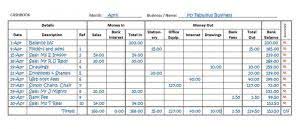
According to this practice, time utilization is effectively higher and the billable rate is lower. For example, you can agree that the time you spend commuting to the client’s offices isn’t billable, even though that time de facto does impact working with them. Another option is that the commute time charges for half the billable rate. For example, an employee who has worked on an earlier project can have a set target rate of $115/hour.
Clockify: A Free and Simple Time Tracking Tool
Billable hours are the hours worked for which you can bill the client, while actual hours worked may include time spent on other projects that can’t be charged to your client. In order for time to be billable, it must be spent directly on client work. If you’re not sure whether a specific task is billable, consider whether it’s necessary for the project and actively advances progress.

How Can You Calculate Billable Hours?

Consider them not only as necessary upkeep to keep your agency’s baseline functioning but also as an investment into your future. For example, non-billable work such as employee education, investing in outreach, and client prospecting, are all critical activities for your agency’s continued success. Adopting best practices for tracking billable hours can significantly enhance your operational efficiency. Whatever the case, registering time and keeping track of billable hours is paramount if you want to know what to expect from your projects in terms of timing and budgeting.
How to Group Numbers in Excel

For example, if your hourly rate is $50 and you work 40 hours, your total income would be $2,000. That means that up to 80% of your time should account for billable work (for many, this can be a pretty tough target to meet). You could walk out of a non-billable networking event with potential new clients, and a well-curated pitch could land you a major contract.
- From the moment you wake up to the moment you go to bed, track what you’re doing every 30 minutes.
- Once you and the client have settled on an hourly rate, you can go about creating an invoice in one of several ways.
- This approach boosts team productivity, increases billable value, and improves the firm’s profitability.
- Keeping your billable hours high involves keeping your non-billable hours low — at least, as low as you can without eliminating the important and necessary work that this time can hold.
- If you charge different rates for different services or individuals, make sure to keep all the hours for different services separate.
- This lack of structure often leads to inefficiencies that hinder productivity.
- For instance, in a legal firm, attorneys diligently track the hours dedicated to client cases, which are subsequently invoiced as outlined within the agreement.
- But knowing how to keep track of billable and non-billable activities can be a constant challenge when you’re a small business or starting out as a contractor or freelancer taking on new clients.
- It automatically tallies up your billable hours from the timesheets, calculates utilization rates as well as tracks hours spent on non-billable work.
- Tracking billable hours can feel like trying to juggle a dozen balls at once, especially when you’re managing multiple clients or projects.
- Traqq is an efficient and free time tracking app for remote teams, freelancers, and businesses alike.
- Such data-driven evaluation allows for fair and objective performance appraisals for all employees.
- It’s difficult to argue with numbers — if you can show you are spending 40 hours working each week instead of the 35 you had earlier agreed to, then your client will be willing to add 5 more hours.
Moreover, seamless integration with other tools used in your organization is easily achievable. If you have any queries, net sales simply sign up for a free trial and streamline your timesheet management process. If you’re a small business with only a handful of employees, tracking billable hours may not be worth your time and energy. First and foremost, is your business model conducive to billing by the hour (most business are nowadays)? If not, then it’s probably not worth tracking billable hours because it won’t be an accurate reflection of how much work is actually being done. Once you’ve got a good idea of how much time you’re spending on billable tasks, you can begin to calculate your billable hours.

This is important for figuring out effective time utilization and actual billable rate. Prove how much time you spend working, so it can be easy to negotiate a higher salary or billing rate. It’s difficult to argue with numbers — if you can show you are spending 40 hours working each week instead of the 35 you had earlier agreed to, then your client will be willing to add 5 more hours.
A billable hours chart will help project managers, clients, and yourself to how many billable hours in a year were used in a particular project. A time tracking system with a billable hours what are billables calculator will help you to efficiently track billable hours and ensure you get paid as you should. When employees fail to track their time properly, it can wreak havoc on company finances.

By organizing your tasks this way, you can tackle critical activities first, ensuring that essential deadlines are met. RescueTime offers an efficient way to track and manage how much time you spend on your computer or smartphone, resulting in increased productivity. Tackle revolutionizes time tracking through seamless calendar integration, eliminating the need for manual logging. Our platform automatically captures and categorizes your time, providing actionable insights through https://www.bookstime.com/ intuitive dashboards and reports. By documenting where your time goes, you can pinpoint these distractions and take actionable steps to eliminate or better manage them. Many individuals go through their workdays without a clear plan, losing track of how their time is spent.
